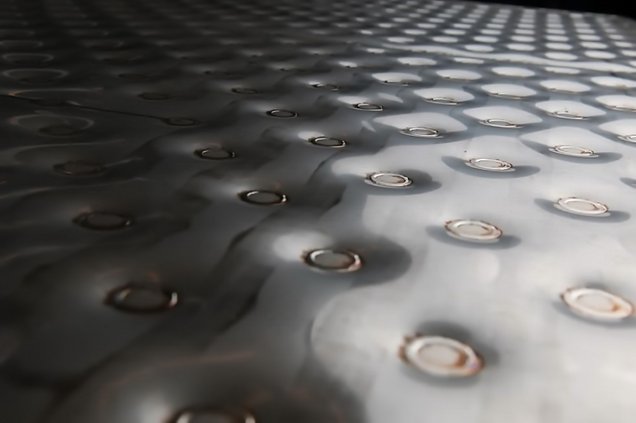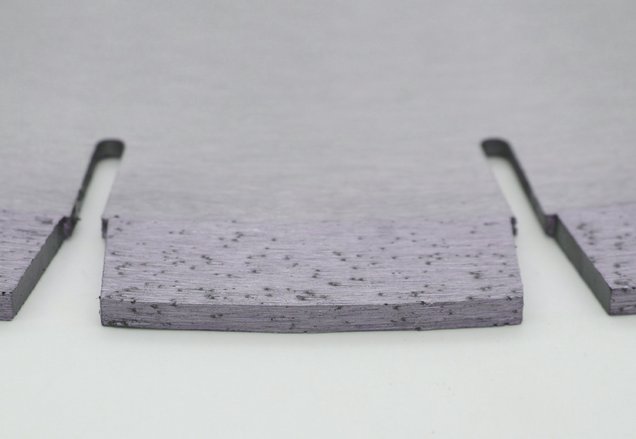Laser Welding of Pillow Plates

Laser Welding of Pillow plates
Low cost automatic Production of pillow plates
Pillow Plates, also called dimpled plates or thermo plates, consists of two stainless steel sheets that are laser welded together by welding a custom circle weld pattern. Then the plate is inflated by using water pressure, which creates a specific single or double embossed profile – the pillow plate, through which the cooling or heating is conducted. The thickness and the spot pattern are determined by the pressure requirements.
PillowPlate or dimpled jacket plates
Laser welded cooling plates
The wobble cube is able to produce PillowPlates which can be used for a large range of products, such as; heat exchangers, filter housings, falling film, square containers, cooled containers, offen walls, climate chambers, ice accumulators, pipes, heated or cooled vibration feeders and in cylindrical tanks, as well as in tanks of other shapes and designs, for example rectangular or oval ones. They can also be used for various industries for example food and beverage industries and other food-making and process industries. The surface can be brushed, polished or sandblasted. Possibilities are endless because you can produce every weld pattern shape and any required plate shape can be welded or engraved. The PillowPlates can be single or double embossed plates.
Laser Wobble Welding in Battery Pack assembly
Getting Better Performance and Higher Currents from Battery Packs with our Laser Wobble Welding Technology

Growing EV battery market demands better joining solutions: Wobble laser Welding is the best
Laser Beam Welded Joints for Lithium-Ion Batteries
The growing electrification of vehicles and tools increases the demand for low resistance contacts. Today’s batteries for electric vehicles consist of large quantities of single battery cells to reach the desired nominal voltage and energy. Each single cell needs a contacting of its cell terminals, which raises the necessity of an automated contacting process with low joint resistances to reduce the energy loss in the cell transitions. A capable joining process suitable for highly electrically conductive materials like copper or aluminium is the laser beam welding.
Over the past years, the demand for large battery packs for electric vehicles (EV) has steadily increased with the ongoing electrification of the transportation sector and a growing demand for greater ranges. State of the art EV battery packs consist of a large quantity of cells connected in series to achieve
the desired voltage level and in parallel in order to enable higher charge- and discharge-currents.
For example, the EV Tesla Model S comprises of total count of over 7000 type 18,650 battery cells inside its battery pack. A single defective connection can lead to failure or a reduction in performance.
The quality of the joint has a decisive influence on the sustainability and safety of electric vehicles: Increased resistance at a welded joint causes more heat loss at this spot and leads to an increased electrical and thermal load on the individual cells, which in turn can lead to failure or accelerated aging.
Laser beam welding is a promising technology to contact battery cells enabling automated, fast and precise production of conductive joints. In comparison to other conventional welding techniques, such as resistance spot welding, the laser beam welding has a reduced thermal energy input. Compared to ultrasonic welding, the laser beam welding technique does not induce a mechanical force. The resulting transition resistances are in the range of the basic material resistances. The overall performance of the battery pack is therefore improved by the reduction of the ohmic resistance of the joints and heat loss inside the battery cell.
High currents must flow through the welds between battery cells in order to deliver the electricity needed to power a battery electric vehicle. These welds are the bottleneck of the electric circuit. Electrical resistance causes the temperature in the welds to raise when a current is conducted. This temperature increase may be harmful to lithium-ion battery cells. Therefore, larger weld areas which are created with our wobble laser system, and thus lower resistance. Thewelds made by wobble welding system increase the mechanical strength of the welds drastic, and reduce the temperature and thermal stress at the joints. Considering this, Wobble Laser Welding is much more suitable for battery tab joining than other types of welding.
Furthermore, laser beam welding produces a small heat-affected zone. Hence, it is crucial to understand how much heat is generated in the weld and whether the heat can damage the battery. Lithium-ion batteries must operate within a safe and reliable operating area, which is restricted by temperature and voltage windows. Exceeding the restrictions of these windows will lead to rapid attenuation of battery performance and even result in safety problems.
In the context of production, laser beam welding is well suited to be integrated into almost fully automated production lines in the manufacturing process of battery packs and EVs.
Laser Welding in Diamond Sawblade production

Laser welded diamond saw blades have a longer life and cut faster than sintered diamond blades, it provides safety and reliable cuttings to the users.
Laser Welding of Schaft with Splines

